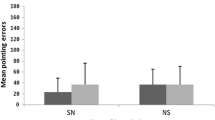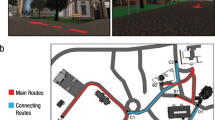Abstract
Adults can make judgments about multiple spatial relations based on information gained from different kinds of input, including maps, descriptions, and through navigation [1]. However, factors such as spatial orientation influence performance. We investigated spatial orientation effects on learning from different media. In Experiment 1, participants learned a house from a map or a description. They then judged surrounding locations while imagining being in each room and they reconstructed the house. Participants who learned from a description performed worse on both tasks. Errors suggested they interpreted the term “in front” differently than intended [2]. Experiment 2 tested this hypothesis by examining two factors influencing interpretation of “in front”, specific interpretation instructions and orientation information. The orientation information influenced performance more than the explicit interpretation of “in front.” Taken together, the results indicate multiple influences on the spatial reference frame participants use to interpret spatial terms.
Access this chapter
Tax calculation will be finalised at checkout
Purchases are for personal use only
Preview
Unable to display preview. Download preview PDF.
Similar content being viewed by others
References
Taylor, H.A. and B. Tversky: Spatial mental models derived from survey and route descriptions. J. Mem. Lang. 31 (1992) 261–292
Hill, C.: Up/down, front/back, left/right: A contrastive study of Hausa and English. In: J. Weissen and W. Klein, Editors: Here and there: Crosslinguistic studies on deixis and demonstration. Benjamins, Amsterdam (1982) 13–42
Presson, C.C. and M.D. Hazelrigg: Building spatial representations through primary and secondary learning. J. Exp. Psychol. Learn. 10 (1984) 716–722
Evans, G.W. and K. Pezdek: Cognitive mapping: Knowledge of real-world distance and location information. J. of Exp. Psychol.—Hum L. 6 (1980) 13–24
Leiser, D., J. Tzelgov, and A. Henik: A comparison of map study methods: Simulated travel vs. conventional study. Cah. Psychol. Cogn. 7 (1987) 317-334
Perrig, W. and W. Kintsch: Propositional and situational representations of text. J. Mem. Lang. 24 (1985) 503–518
Sholl, M.J.: Cognitive maps as orienting schemata. J. Exp. Psychol. Learn. 13 (1987) 615–628
Thorndyke, P.W. and B. Hayes-Roth: Differences in spatial knowledge acquired from maps and navigation. Cognitive Psychol. 14 (1982) 560–589
Golledge, R.G. and N.A. Spector: Comprehending the urban environment: Theory and practice. Geogr. Anal. 14 (1978) 305–325
McNamara, T.P., J.K. Hardy, and S.C. Hirtle: Subjective hierarchies in spatial memory. J. Exp. Psychol. Learn. 15 (1989) 211–227
Taylor, H.A. and B. Tversky: Descriptions and depictions of environments. Mem. Cognition. 20 (1992) 483–496
Taylor, H.A. and B. Tversky: Perspective in spatial descriptions. J. Mem. Lang. 35 (1996) 371–391
Ehrich, V. and C. Koster: Discourse organization and sentence form: The structure of room descriptions in Dutch. Discourse Process. 6 (1983) 169–195
Shanon, B.: Room descriptions. Discourse Process. 7 (1984) 225–255
Levelt, W.J.M.: Cognitive styles in the use of spatial direction terms. In: R.J. Jarvella and W. Klein, Editors: Speech, place, and action. Wiley, Chichester, United Kingdom (1982) 251–268
Levelt, W.J.M.: Some perceptual limitations on talking about space. In: A.J. van Doorn, W.A. van der Grind, and J.J. Koenderink, Editors: Limits in perception. VNU Science Press, Utrecht (1984) 323–358
Carlson-Radvansky, L.A., E.S. Covey, and K.M. Lattanzi: “What” effects on “where”? Functional influences on spatial relations. Psychol. Sci. 10 (1999) 516–521
Carlson-Radvansky, L.A. and D.A. Irwin: Frames of reference in vision and language: Where is above? Cognition. 46 (1993) 223–244
Schober, M.F.: Spatial perspective-taking in conversation. Cognition. 47 (1993) 1–24
Levinson, S.C.: Frames of reference and Molyneux’s question: Crosslinguistic evidence. In: P. Bloom, et al., Editors: Language and space. The MIT Press, Cambridge, MA (1996) 109–169
Halpern, D.F., Sex differences in cognitive abilities. 3rd ed. 2000, Mahwah, NJ: L. Erlbaum Associates. 420.
Taylor, H.A., et al.: Is the donut in front of the car? An electrophysiological study examining spatial reference frame processing. Can. J. Exp. Psychol. 55 (2001) 177–186
Author information
Authors and Affiliations
Editor information
Editors and Affiliations
Rights and permissions
Copyright information
© 2001 Springer-Verlag Berlin Heidelberg
About this paper
Cite this paper
Taylor, H.A., Uttal, D.H., Fisher, J., Mazepa, M. (2001). Ambiguity in Acquiring Spatial Representation from Descriptions Compared to Depictions: The Role of Spatial Orientation. In: Montello, D.R. (eds) Spatial Information Theory. COSIT 2001. Lecture Notes in Computer Science, vol 2205. Springer, Berlin, Heidelberg. https://doi.org/10.1007/3-540-45424-1_19
Download citation
DOI: https://doi.org/10.1007/3-540-45424-1_19
Published:
Publisher Name: Springer, Berlin, Heidelberg
Print ISBN: 978-3-540-42613-4
Online ISBN: 978-3-540-45424-3
eBook Packages: Springer Book Archive




